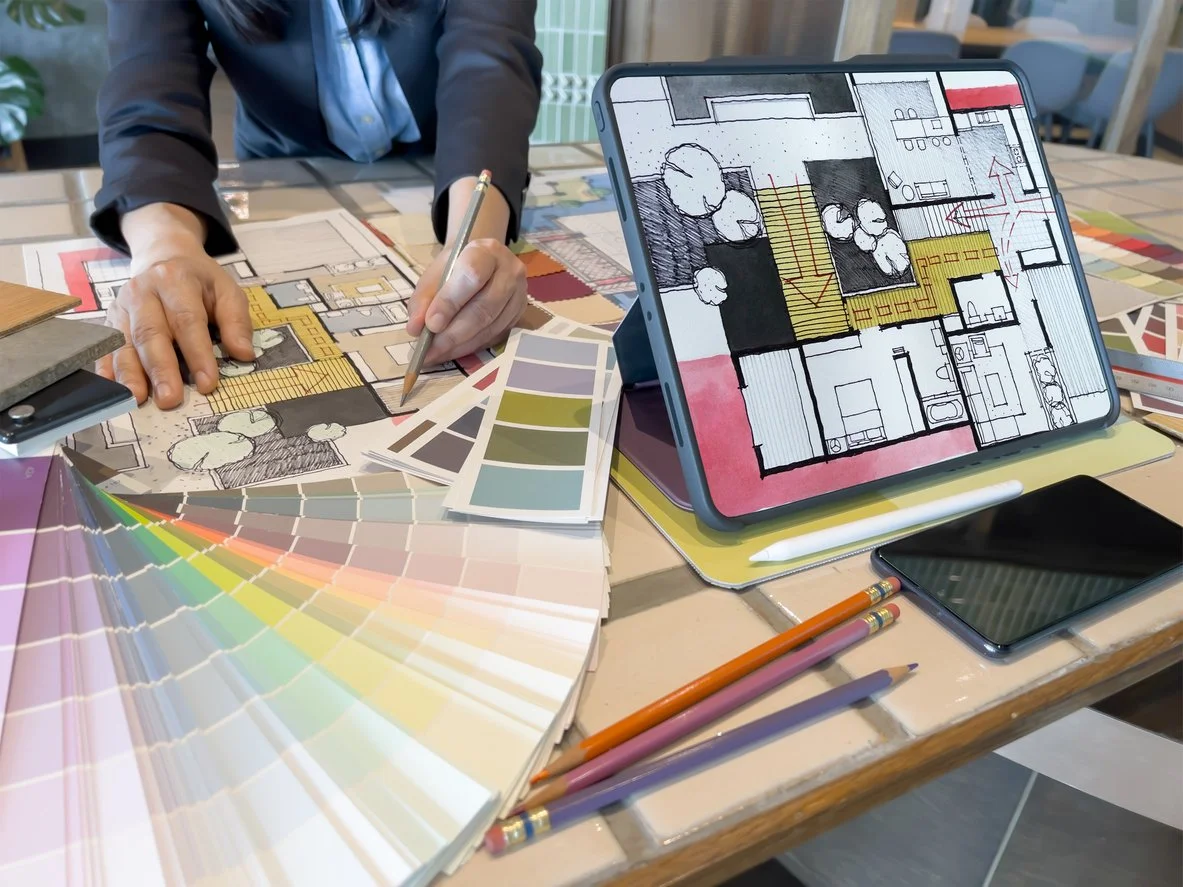Interior Designer Client Presentation Tips
To nail your interior design client presentation, focus on creating a strong visual narrative through professional mood boards, 3D renderings, and detailed floor plans. You'll want to maintain brand consistency while incorporating interactive elements like material samples and digital walkthroughs. Clear communication is key - use open-ended questions, schedule regular check-ins, and document client feedback thoroughly. Present your timeline in digestible segments and leverage technology for real-time adjustments. There's much more to discover about making your design presentations truly engaging.
Article Main Points
Create a compelling visual story through mood boards and 3D renderings that showcase your design concept and materials selection.
Present a clear project timeline with defined phases, milestones, and realistic completion dates for client understanding.
Use high-quality presentation materials including floor plans, material samples, and digital walkthroughs to enhance client visualization.
Listen actively and ask open-ended questions during presentations to understand client preferences and address concerns immediately.
Maintain brand consistency throughout presentation materials while connecting design choices to the client's personal style and needs.
Essential Elements of a Winning Design Presentation
When preparing a winning interior design presentation, incorporating essential components will help you effectively communicate your vision and secure client approval.
Begin with a strong concept statement that outlines your design narrative and inspiration. These concepts should be aligned with preferences of your client to ensure satisfaction. The initial design phase requires 2-4 weeks to thoughtfully develop the creative direction. Then, create visual cohesion through a carefully curated mood board that showcases your palette, textures, and style direction. Consider creating presentation files that support both digital and in-person delivery formats to accommodate various meeting scenarios. The use of hand-drawn sketches can effectively express your initial design ideas and concept development. A comprehensive project timeline helps manage expectations and outlines key milestones.
Your presentation must include these key elements:
A detailed floor plan showing space optimization
High-quality 3D renderings that bring your vision to life
Thorough material and finish selections
Don't forget to organize your samples by room and prepare professional-grade visualizations.
You'll want to demonstrate how each element contributes to the overall design story, showing clients you've thoughtfully considered their needs while maintaining a sophisticated aesthetic that commands attention and respect.
Creating Professional Design Presentation Materials
Three critical components form the foundation of professional design presentation materials: polished templates, consistent branding, and organized content structure.
You'll want to leverage modern visual design techniques to create compelling presentations that showcase your expertise and command attention.
Start with a professionally designed cover page that includes your branding, project name, and client details.
Then, implement engaging presentation styles through:
Clear section divisions for scope, timeline, and budget
Strategic use of mood boards and floor plans
Professional PowerPoint templates with master slides
Brand-aligned color schemes and graphics
Reusable slide layouts for efficiency
Don't forget to incorporate detailed project timelines and budget breakdowns - they're essential for demonstrating your organizational prowess and attention to detail.
These elements will help you deliver presentations that exude confidence and professionalism.
Mastering the Art of Client Communication
Your ability to communicate effectively with clients can make or break your success as an interior designer. To master client engagement, you'll need to develop a strategic approach that combines active listening with clear, purposeful dialogue.
Here's how to elevate your communication game:
Ask open-ended questions to uncover deeper client preferences
Use reflective responses to confirm understanding
Monitor non-verbal cues for hidden insights
Implement regular feedback strategies through scheduled check-ins
Leverage technology to enhance your client communications:
Utilize project management tools for streamlined updates
Create interactive presentations for real-time collaboration
Share visual aids like mood boards and 3D renderings
Remember to tailor your presentation style to each client's preferences, demonstrating your commitment to their unique vision while building lasting professional relationships.
Setting the Stage for a Successful Meeting
The foundation of a stellar client presentation begins long before the actual meeting takes place. You'll need to master your project preparation by diving deep into your client objectives and design goals.
Start by crafting a detailed meeting agenda that'll guide your presentation flow while ensuring you've got all necessary visual aids at your disposal.
To maximize client engagement, you'll want to:
Research your client's specific needs thoroughly
Prepare extensive documentation
Organize your presentation materials strategically
Set up clear feedback mechanisms
Don't forget to establish strong communication strategies and outline project timelines upfront.
When you're well-prepared, you'll command the room with confidence and demonstrate your expertise.
Remember: thorough preparation isn't just about impressing your client—it's about setting yourself up for a successful project from day one.
Building Trust Through Visual Storytelling
Building trust with clients requires masterful visual storytelling that goes beyond simple design presentations. You'll need to craft a compelling visual narrative that resonates with your client's aspirations while demonstrating your expertise.
To create a powerful emotional connection:
Present your design concepts through multiple formats - combine 3D renderings, mood boards, and floor plans to help clients visualize the complete story.
Share relevant success stories from past projects that mirror your current client's goals.
Explain your design choices by connecting them to the client's personal journey and needs.
Remember to let your visuals breathe - don't overwhelm with unnecessary explanations. Instead, guide clients through the space's flow, highlighting how each element contributes to their unique narrative.
Your confidence in presentation will naturally build their trust in your vision.
Presenting Design Concepts With Confidence
Your design authority shines through when you confidently present your concepts with compelling visual elements that bring your vision to life.
You'll establish instant credibility by walking clients through detailed 3D renderings, material samples, and well-organized design boards that showcase your expertise and attention to detail.
When you pair these strong visuals with clear explanations of your design decisions, you'll help clients feel secure in your ability to transform their space into something extraordinary.
Show Your Design Authority
Successfully presenting design concepts requires a delicate balance of confidence and expertise while maintaining an approachable demeanor.
To establish your design authority and build client trust, you'll need to showcase your expertise through well-prepared presentations and confident delivery of your ideas.
Lead with Experience: Share relevant past projects and design solutions that demonstrate your deep understanding of spatial relationships and material selection.
Command the Room: Dress professionally and maintain confident body language while presenting your concepts through high-quality 3D renderings and mood boards.
Guide the Conversation: Take control by structuring your presentation chronologically, explaining your design rationale clearly, and addressing potential concerns before they arise.
Engage With Visual Impact
When presenting design concepts to clients, powerful visual elements serve as your most compelling communication tools.
To maximize visual engagement, leverage these proven techniques:
Create stunning mood boards that showcase your design direction through carefully curated impactful imagery, material samples, and color palettes.
Utilize professional 3D renderings to help clients visualize the final space with remarkable clarity.
Present floor plans and elevations that demonstrate your technical expertise while making spatial relationships easy to understand.
Don't rely on words alone - let your visuals do the heavy lifting.
Support your presentation with:
High-quality photos of similar completed projects
Material and finish samples clients can touch
Digital walkthroughs that bring spaces to life
Interactive elements that encourage client participation
Remember: strong visuals build confidence and drive decisions.
Streamlining Project Timeline and Deliverables
To effectively present interior design projects to clients, streamlined timelines and clear deliverables serve as the foundation for success.
By mastering project phases and timeline management, you'll demonstrate your expertise while keeping clients confident in your process. Breaking down the timeline into digestible segments helps clients understand the journey ahead.
Pre-Design (2-3 weeks): Start with a discovery call and brief creation to establish clear expectations and gather essential information 🎯
Design Development (4-8 weeks): Create mood boards, 3D renderings, and detailed plans to bring your vision to life.
Execution (6-12 weeks): Handle procurement, oversee installation, and manage contractors with precision.
Remember to build in buffer time for unexpected challenges while presenting your timeline.
This strategic approach showcases your professional capability and guarantees client satisfaction throughout the project's duration.
Managing Client Feedback and Expectations
Building a successful client relationship starts with actively listening to your client's needs and vision before sharing your own design ideas.
You'll find it essential to establish clear project boundaries from day one, including timelines, budgets, and communication preferences - all of which should be documented in writing.
Take detailed notes during every client meeting and design decision discussion, as this documentation will prove invaluable when questions arise or changes need to be made throughout the project.
Listen Before Speaking
Successful interior design projects hinge on your ability to truly understand your client's vision before presenting your own ideas. Through active engagement and attentive observation, you'll gain valuable insights that will shape your design strategy and strengthen your client relationships.
Master these three essential listening techniques to dominate your client consultations:
Command the conversation by asking specific, targeted questions that reveal your client's true preferences and lifestyle needs.
Demonstrate your expertise through strategic note-taking and maintaining unwavering eye contact during client discussions.
Take control of the feedback process by implementing multiple communication channels that suit your client's preferences.
Don't rush to present solutions. Instead, leverage your listening skills to gather thorough information that will power your design decisions and showcase your professional authority.
Set Clear Project Boundaries
Once you've mastered the art of listening to your clients, you'll need clear boundaries to transform their vision into reality. Start by establishing strong communication policies that outline your availability and response times. Define your office hours and preferred contact methods upfront to maintain control of your time.
When discussing project scope, be direct about what's achievable within their budget and timeline. Consider these essential boundaries:
Set specific feedback windows during the project
Create structured communication channels (email for documentation, calls for urgent matters)
Define contractor roles and timelines clearly
Establish realistic budget expectations early
Remember: Strong boundaries aren't about limiting client interaction - they're about creating a framework for success. Include these parameters in your contract to guarantee everyone's on the same page from day one.
Document Every Design Decision
A detailed record of every design choice serves as your project's foundation and safeguard.
Through extensive design documentation, you'll establish clear expectations and protect both your creative vision and professional interests. Your thorough approach to client communication will demonstrate authority and build lasting trust.
Make your documentation power moves count by including:
Detailed drawings with precise dimensions, material specifications, and design notes that leave no room for misinterpretation.
Supporting schedules that showcase your command over every project element, from furniture selection to lighting concepts.
Budget clarification documents that demonstrate your financial acumen and protect your design decisions.
Leveraging Technology in Design Presentations
Modern technology has revolutionized the way interior designers present their creative visions to clients.
You'll command greater authority and influence by leveraging Virtual Reality, Augmented Reality, and interactive presentations to showcase your designs. Through 3D visualization and CAD software, you're able to demonstrate your concepts with unparalleled precision and impact.
Digital collaboration tools have transformed client engagement, allowing you to make real-time adjustments while presenting.
You can now:
Create immersive VR walkthroughs of spaces
Implement smart technology solutions seamlessly
Generate detailed 3D models instantly
Offer interactive design modifications on the spot
Maintaining Brand Identity Throughout Your Pitch
While digital tools elevate your presentation capabilities, your brand's identity remains the foundation of every successful client pitch. Your visual identity must shine through every element of your presentation, from your color schemes to your typography choices.
When you maintain brand consistency, you'll build trust and recognition with your clients.
To dominate your presentation while staying true to your brand:
Create a powerful first impression by incorporating your signature colors and logo placement strategically throughout your pitch materials.
Showcase your unique design philosophy through carefully curated project examples that reflect your brand's aesthetic.
Demonstrate authority by using your brand's established tone of voice in all written and verbal communication.
Frequently Asked Questions
-
Don't take it personally. Gather specific client feedback to understand their concerns, then leverage this insight to propose strategic design revisions. You're in control - use this opportunity to showcase your problem-solving expertise.
-
Like steering a ship through stormy seas, you'll need to firmly take control. Establish clear client communication checkpoints, show design flexibility within set boundaries, and don't let indecision derail your presentation's momentum.
-
You'll dominate presentations by bringing physical samples alongside digital versions. Take control by letting clients touch materials while you guide them through digital presentations. It's your power move to guarantee confident decision-making.
-
Like a well-timed cavalry charge, you'll want to keep your presentation duration tight - aim for 45-60 minutes. This maximizes client engagement while respecting their time, ensuring you maintain control of the room.
-
You'll build client trust by clearly demonstrating your value perception through detailed breakdowns of deliverables, highlighting your expertise, and showcasing past successful projects. Don't apologize for your fees - confidently explain your worth.



















